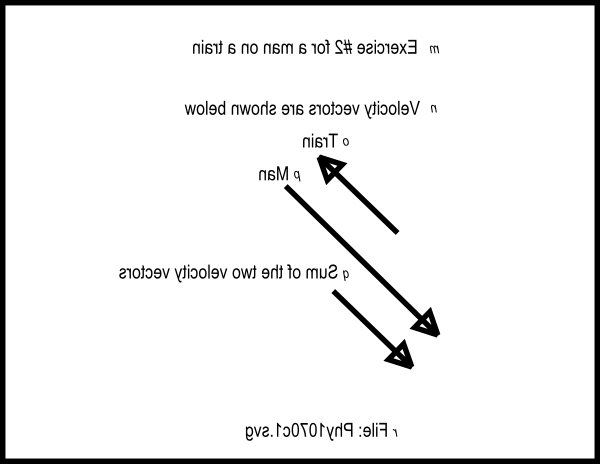| << Chapter < Page | Chapter >> Page > |
We will specify a different common direction for the train and the man in the next exercise.
A man is walking in a passenger car of a train that is moving at 1 mile per hour toward the northeast (45 degrees). The man is walking in the opposite direction than the train is moving at 2.933 feet per second. (Thismeans that the angle for the man's velocity vector is 225 degrees.)
What is the man's velocity with reference to the ground?
Tactile graphics
An svg file named Phy1070c1.svg is provided for the creation of a tactile velocity vector diagram for this scenario. The table of key-value pairs for thisfile is provided in Figure 8 .
| Figure 8 . Key-value pairs for the image in Phy1070c1.svg. |
|---|
m: Exercise #2 for a man on a train
n: Velocity vectors are shown belowo: Train
p: Manq: Sum of the two velocity vectors
r: File: Phy1070c1.svg |
The image contained in this file is shown in Figure 9 for the benefit of your assistant who will manually emboss the diagram. Anon-mirror-image version is shown in Figure 16 .
The units for both velocity vectors must be the same. Therefore, the length ofthe velocity vector for the man is based on a conversion from 2.933 feet per second to 2 miles per hour.
| Figure 9 . Mirror image contained in the file named Phy1070c1.svg |
|---|
 |
Make a new html file
Please copy the code from the previous exercise into a new html file, make the changes described below, and open the html file in your browser.
(Because of the small differences between this script and the previous script, I won't publish a copy of this new script here.)
Screen output
The text shown in Figure 10 should appear in your browser window when you open the file in your browser.
| Figure 10 . Screen output for Exercise #2 for a man on a train. |
|---|
Start Script
Velocity magnitude = 1.00 miles/hourVelocity angle = 225.00 degrees
End Script |
Analysis of the results
The man and the train are still moving along the same straight line even though the angle is no longer 0. Therefore, the magnitudes of the two vectorsstill add algebraically. In this case, however, the man and the train are moving in opposite directions, so they are no longer additive.
The man has a greater velocity magnitude
The magnitude of the man's velocity in the direction of 225 degrees is greater than the magnitude of the train's velocity in the opposite directionof 45 degrees.
As you can see from Figure 10 , the man's velocity with reference to the ground is 1 mile per hour at an angle of 225 degrees. This means that an observer standing on theground at a point on a line perpendicular to the train would perceive the man to be moving to the left at 1 mile per hour (assuming that the train is moving to the right).
Now we are going to take a look at an exercise involving three vectors in a plane, which are not in a line.
An aircraft carrier is steaming east with a uniform velocity of 2 miles per hour relative to the ground beneath the ocean. A large platform on the deck is sliding northeast with a uniformvelocity of 2 miles per hour relative to the ship. A man is walking north on the platform with a uniform velocity of 2 miles per hour relative to the platform.

Notification Switch
Would you like to follow the 'Accessible physics concepts for blind students' conversation and receive update notifications?